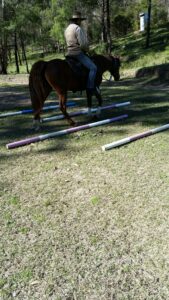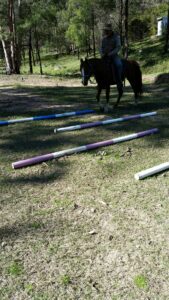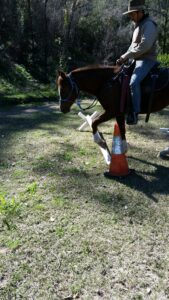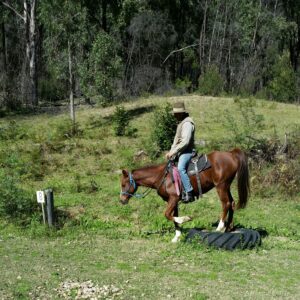In an excellent article about the significance of connection, Jo Spiller says
So how do you create this partnership? You don’t do anything to create it, because it’s not a matter of doing. It is much more a matter of who you are being. You see, we have language for doing things: we can say ‘Put your heels down’, ‘Sit up straight’… but nobody can tell you how to do ‘being’.
After years of teaching riders and training horses, Spiller says that she suddenly saw what had been there in plain sight. She’d been too busy doing things to see that the basis of good horsemanship was the capacity to develop a connection with horses. And, ‘in order to achieve that connection’, she realized, we ‘must undergo a transformation’, a change in form of being.
I have been speaking about this transformation as an ‘interbeing’ and, more specifically, as a human-and-horse being. As Spiller implies, there isn’t a ready language for speaking about ways and forms of being. In writing these posts, my primary interest has been in finding such a language, and specifically, one that is true to the experience of being in-relation with horses. To help think about how this form of being comes about, I want to introduce the idea of imagination.
In the previous post, I suggested looking at photos of Corey and Pia and imagining your way into those experiences of softness in horse-and-human. Here are some more photos, this time, of Corey with my other horse, Peridot. If you can imagine this experience, I think you will be experiencing it yourself, feeling it with your whole body. While imagination is often thought of as merely a mental image, a visualisation, I’m speaking of it in this way, as a full-bodied, alive experience. Through imagining horse-and-human, we become a horse-and-human being.
So, what does the imagining of horse-and-human feel like? In these pictures of Cory and Peridot moving around poles, over a cavalletti, over a tyre, you might notice that the reins are loose, that Peridot is relaxed and happily engaged in the process – she is clearly not being made to do anything. And, movements are happening with care, rhythm and balance. I imagine that Corey is living-imagining the turns in horse-and-human body, the precise placing of horse-and-human feet-hooves, the stretching out of the neck with relaxation, the horse-and-human muscles climbing over the tyre, and the rhythm of horse-and-human walk. Peridot and Corey are getting in-tune with horse-and-human rhythms. And in those moments when it all ‘comes together’, there is no identifiable source of any movement. They happen, with ease.
 Corey is working with focus here. While focus is an important aspect of leadership and support, I think that recognising the role of imagination in this activity can help avoid thinking of it in human-centred, goal-directed terms. Focus here involves imagining-living a horse-human movement. Corey often says that focus is not so much about your eyes as your gut – it comes from the core of your being. A being in-relation, more basic than being any-thing.
Corey is working with focus here. While focus is an important aspect of leadership and support, I think that recognising the role of imagination in this activity can help avoid thinking of it in human-centred, goal-directed terms. Focus here involves imagining-living a horse-human movement. Corey often says that focus is not so much about your eyes as your gut – it comes from the core of your being. A being in-relation, more basic than being any-thing.
The centaur is, of course, the archetypal figure of horse-and-human imagining. While I’m happy to use this term, I have reservations about visual representations of the centaur as half human and half horse. This is not how it feels. When living-imagining a true interbeing you can’t tell what’s ‘horse’ and what’s ‘human’. This is the wonder of these experiences – our very being is a part of an experience of difference which has the feeling of an unbounded intertwining, with no clear borders between horse and human and environment. We are experiencing that interconnected form of being that is more fundamental, deeper, than any identifiable being.
Furthermore, you don’t have to be sitting on a horse to have this sort of centaur experience. Living-in-relation with horses involves a great deal more than riding, and, indeed, establishing a trustworthy connection is essential before getting on a horse. So, it is important that we live-imagine horse-and-human, or the centaur, in every encounter with horses – in a paddock, putting on a halter, standing next to each other, grooming, walking together… I have had experiences of intertwining when walking up a hill through bush with Peridot, moments when we were completely in-tune as we picked our way together over fallen branches, rocks, slippery ground. There was slack in the rope between us, I was not using cues. We were, as Corey would say, ‘on song’ together. And, what made this possible was a capacity, in those moments, to imagine horse-and-human, a capacity to inter-be.
I have implicitly been describing relational space here, the spatial counterpart to non-linear time. When we are in-relation with horses, there is no sense of a measurable distance or boundaries between distinct entities, ‘human’ here and ‘horse’ there. Rather, we experience a here-and-there all at once, an intertwining of being, whether or not we are in physical contact. Furthermore, when in-relation, we don’t experience space as empty, mere absence, but, rather, as full and alive. And, in those wonderful experiences of flow, there is no locatable point of origin because it comes through the life of a relation, an unfolding whole.
Of course, we drop in and out of a relational form of being, and in and out of connection with our horses. And so, while we always have the potential to be a horse-and-human being, it takes practice. This is where imagination, in a certain sense, can help. Through an imagining practice we can tap into that potential, and, for this, you don’t have to be near a horse. For example, you might have been living-imagining centaur experiences while reading this post. Spiller is right when she says you can’t tell people how to do being. In fact, no deep learning happens through instruction. So, what I think can help here is remembering those moments of connection with your horse, moments of being in-tune when things happen with ease, and recalling the feel of those experiences. If we reimagine these experiences, it will help us embody the form of being that makes a connection with horses possible.
You can’t tell people how to work with horses through a connection, how to work with feel, as the Dorrance brothers would say, but understanding the process can help us develop this capacity for connection, a capacity to let go of self-centred being. Again, this brings us back to the primary importance of awareness – awareness of our state of being, awareness of what is happening for our horse, awareness of what is happening in our connection with our horse, awareness of our environment… Awareness is itself a relational capacity.
In the next post I’ll look at the significance of feedback in working through connection and feel, and return to the theme of leadership, addressing the role of feedback in leadership through listening.
With thanks to Andrew, Corey, Suzi

Interesting deep thoughts, there is something to think about. Thanks!